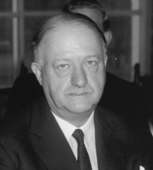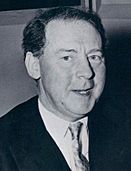Post-war consensus facts for kids
The post-war consensus was a special agreement in Britain after World War II (from 1945 to the late 1970s). It was a time when the main political parties, like the Labour Party and the Conservative Party, mostly agreed on how to run the country. This agreement ended when Margaret Thatcher became the leader of the Conservative Party.
During this time, the government supported things like taking important industries into public ownership (called nationalisation). They also supported strong trade unions, lots of rules for businesses (heavy regulation), high taxes, and a big welfare state. A welfare state means the government helps people with things like healthcare, education, and financial support.
Historians still discuss exactly when this agreement started to weaken and end. They also wonder if everyone truly supported it as much as some people claim.
Contents
How the Post-War Consensus Started
The idea of the post-war consensus was mostly explained by a historian named Paul Addison. He argued that during the 1930s, smart thinkers from the Liberal Party, like John Maynard Keynes and William Beveridge, came up with plans. These plans became very popular during World War II. People wanted a much better Britain after the war.
The main ideas for the post-war consensus came from the Beveridge Report. This report was written by William Beveridge, an economist, in 1942. It suggested a much bigger welfare state for Britain. The report aimed to fix five big problems in society: "Want (poverty), Disease, Ignorance, Squalor (bad housing), and Idleness (unemployment)".
The report suggested several important changes. These included having one minister in charge of all insurance plans. It also suggested a regular payment from working people to an insurance fund. This fund would help with old age pensions, money for new mothers, funeral costs, and support for widows or people injured at work. A very important idea was to create a new National Health Service.
Key Ideas of the Consensus
The post-war consensus included several key beliefs:
- Keynesian economics: This idea, from John Maynard Keynes, said the government should play an active role in the economy. It meant the government should spend money to create jobs and keep the economy stable.
- Mixed economy: This meant some big industries would be owned by the government (like coal or railways). But other businesses would still be privately owned.
- National Health Service (NHS): This was a new system where healthcare was free for everyone, paid for by taxes.
- Welfare state: This meant the government would provide support for people from "cradle to grave." This included help with education, housing, and financial support.
Both the Labour Party and the Conservative Party governments followed these policies after the war. This agreement lasted until the economic problems of the 1970s. These problems led to the end of the good economic times after the war. New ideas, like monetarism (championed by Milton Friedman), started to become popular.
The Attlee Government's Role
The first general election after 1935 happened in July 1945. The Labour Party, led by Clement Attlee, won by a huge amount. The policies that Attlee's government put in place formed the basis of the consensus.
The Conservative Party accepted many of these changes. They even promised not to undo them in their 1947 Industrial Charter. Attlee used the ideas from the Beveridge Report and Keynes's economics to create what was called "The Attlee Settlement."
This settlement focused on:
- A mixed economy (government and private businesses).
- Making sure almost everyone had a job (full employment).
- Working with trade unions.
- Building a strong welfare system.
- Gradually giving independence to parts of the British Empire.
Areas of Agreement in Policy
During World War II, the government, led by Winston Churchill and Clement Attlee, promised a much better welfare state after the war. These promises included the National Health Service, better education, more housing, and other welfare programs. They also included taking over some struggling industries.
Education and Healthcare
In education, a big change was the Education Act 1944. This law was written by a Conservative, Rab Butler, and a Labour politician, James Chuter Ede. It improved and updated the education system. This act became a key part of the consensus. The Labour Party also didn't challenge the system of private "public schools."
The Conservatives also did not challenge the socialized medicine of the National Health Service. In fact, they even said they could run it better.
Foreign Policy Views
In foreign policy, there was also a lot of agreement. Historians Dennis Kavanagh and Peter Morris say that the experiences of World War II led to shared ideas among the main parties. These included:
- Being close allies with the United States (Atlanticism).
- Having Britain's own nuclear weapons.
- Gradually letting go of the British Empire.
- Being a bit hesitant about joining Europe fully.
These ideas started with the 1945 Labour Government and continued with later governments. However, there were some disagreements, for example, about the Commonwealth. Labour saw it as a multicultural group, while Conservatives sometimes used more "imperial" language. Also, decolonization (giving colonies independence) was a point of disagreement, with Conservatives being more reluctant to give up control.
General Policy Agreement
From 1945 until Margaret Thatcher arrived in 1979, there was a wide agreement among different parties on social and economic policies. This was especially true for the welfare state, nationalized health services, education reform, a mixed economy, government rules, Keynesian economic policies, and full employment.
Most of these policies were accepted by the three main political parties. They were also accepted by businesses, banks, and trade unions. Some historians, like Ralph Miliband, felt the consensus was too modest. They thought it stopped Britain from becoming a fully socialized society.
However, it's important to remember that there wasn't total agreement. For example, the Conservatives did not fully support how the National Health Service would be put into action. Henry Willink, a Conservative health minister, was against the government taking over hospitals. This shows that the idea of a "total consensus" might have been a bit oversimplified.
Butskellism
"Butskellism" was a funny name used in British politics in the 1950s. It described the agreement on economic policy between Rab Butler (a Conservative Chancellor of the Exchequer) and Hugh Gaitskell (a Labour Chancellor). The name came from a magazine article that joked about a made-up person called "Mr. Butskell." It showed how similar their economic ideas were, even though they were from different parties.
Was There Really a Consensus?
There's a lot of discussion about how much of a consensus there really was. Some people even say it was a myth. Paul Addison, who first wrote about the consensus, has debated with others like Kevin Jeffreys, who disagrees. Jeffreys says that many of Labour's plans after 1945 were strongly opposed. He points out that the Conservatives voted against the NHS.
Addison later agreed that he might have "exaggerated" how much agreement there was among the top politicians.
Other historians, like Ben Pimlott, also think the idea of a consensus is like a "mirage." He says that if you look closely, you see a lot of arguments and not much harmony. He notes that "Butskellism" was often used as a criticism, not a compliment.
However, political scientists Dennis Kavanagh and Peter Morris still believe the idea of a consensus is true. They argue that there were clear and major agreements on the economy, full employment, trade unions, and welfare programs. They also say there was agreement on big foreign policy issues.
Dean Blackburn offers another idea. He suggests that the consensus wasn't about agreeing on what society *should be* (ideology). Instead, it was about agreeing on *how politics should be done*. Both parties believed in slow, gradual change rather than big, sudden changes.
Why the Consensus Ended
In the 1970s, conservatives who believed in free markets started to gain power. They felt that the old Keynesian ideas were no longer working for the economy. They looked to thinkers like Friedrich Hayek and Milton Friedman, who promoted Monetarism. Keith Joseph was a key advisor to Margaret Thatcher during this time.
Keynesian economics seemed to stop being the "magic solution" for the economic problems of the 1970s. Britain faced economic struggles with no growth and growing unhappiness. The "Winter of Discontent" (a period of widespread strikes in 1978-79) made people feel that the old system was failing.
Global events, like the 1973 oil crisis, put a lot of pressure on the post-war consensus. Domestic problems also added to this, such as high inflation and industrial strikes. In 1976, the British currency (the pound) fell sharply. The Bank of England ran out of money trying to support it.
Because of this, the government, led by James Callaghan, had to ask the International Monetary Fund (IMF) for a huge loan. In return, the IMF demanded big cuts in government spending and tighter control over money. This marked a shift away from Keynesian economics in Britain. Callaghan himself said that the old idea of spending your way out of a recession no longer worked.
Another reason for the end of the consensus was the idea of "state overload." This means that people demanded more and more from the government during the consensus years. It became impossible for the government to meet all these demands. This problem helped lead to the rise of the "New Right" and Margaret Thatcher.
Thatcher changed many parts of the post-war consensus. For example, her Housing Act 1980 allowed people living in council homes to buy them. However, she did keep some key parts of the consensus, like the nationalized health care. In 1982, she promised Britons that the National Health Service was "safe in our hands."
Many people on the right believed that the consensus was causing Britain's economic problems. They thought their "New Right" ideas were the solution. When the Conservative Party won the 1979 election, they put these new ideas into practice. This brought the post-war consensus to an end.
New Zealand's Experience
Outside of Britain, the term "post-war consensus" is also used for a period in New Zealand's political history. This lasted from the 1930s until 1984. Like in the UK, it was based on an agreement between different groups in society. The government promised workers rights, health, and job security. In return, unions and employers would cooperate.
The main ideas for governments in New Zealand during this time were:
- Keynesian economic policies.
- A lot of government involvement in the economy.
- Government rules for businesses.
- A large welfare state.
See also
- Blatcherism
- Crisis theory
- Gaitskellism
- Golden age of capitalism
- New Deal coalition
- Nordic model



